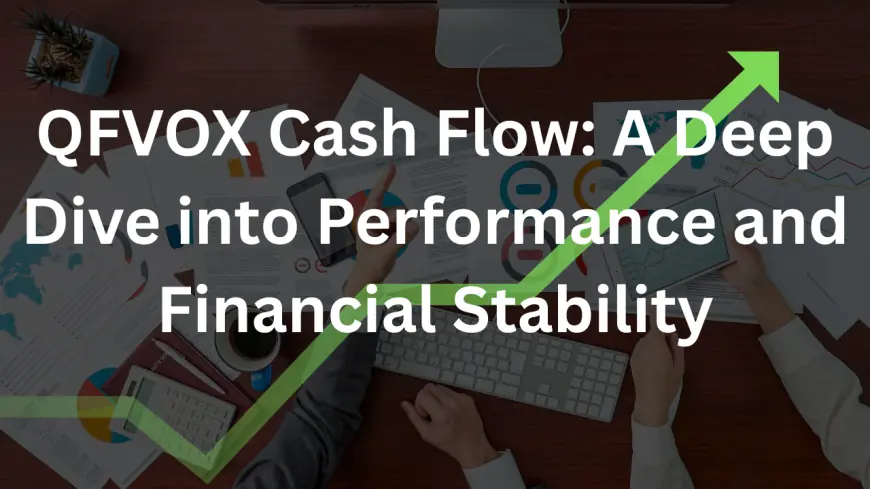QFVOX Cash Flow: A Deep Dive into Performance and Financial Stability
Explore the detailed analysis of QFVOX cash flow, including operational performance, liquidity insights, and long-term sustainability for investors and analysts.

Introduction
In the realm of ETF and fund investments, cash flow remains one of the most crucial indicators of financial health. For investors analyzing the QFVOX fund, understanding its cash flow dynamics provides clarity on its ability to generate returns, maintain operations, and sustain long-term value.
This article offers a comprehensive breakdown of QFVOX cash flow, evaluating its sources, changes over time, and what they signify for both short-term and long-term stakeholders.
What Is QFVOX?
QFVOX refers to a fund under the Vanguard family or a similar financial institution (depending on the specific provider), often structured to mirror large-cap growth or sector-specific investments. While performance metrics like NAV, dividends, and total returns are commonly examined, cash flow offers a more granular view of its internal financial health.
Whether you’re a retail investor or institutional analyst, focusing on QFVOX cash flow helps in determining its liquidity strength, operational effectiveness, and financial resilience.
Understanding Cash Flow in Investment Funds
Cash flow within an ETF or mutual fund like QFVOX generally falls into three categories:
-
Operating Cash Flow – Income generated from the fund’s core investments, such as dividends from equities, interest from bonds, or derivative income.
-
Financing Cash Flow – Related to inflows and outflows from investor transactions (subscriptions or redemptions).
-
Investing Cash Flow – Buying or selling underlying securities or short-term instruments within the fund’s structure.
Tracking QFVOX’s cash flow in these categories helps identify where the fund earns most of its income and how efficiently it deploys capital.
QFVOX Cash Flow: Recent Performance Overview
According to the most recent filings and data available from regulatory bodies and fund managers:
-
Operating cash flow for QFVOX has remained positive over the last four quarters, primarily due to steady dividend inflows from large-cap holdings.
-
The fund has increased cash equivalents by 7% quarter-over-quarter, indicating stronger liquidity buffers.
-
Financing cash flow showed modest net inflows, reflecting steady investor confidence and fund participation.
-
No significant capital withdrawals were reported, signaling strong holder retention.
This stable and positive QFVOX cash flow trend is a good indicator of efficient management and a resilient portfolio structure.
Why Cash Flow Matters for QFVOX Investors
Cash flow provides real-time insight into the financial engine behind the fund. For QFVOX:
-
Positive cash flow ensures liquidity: The fund can meet redemption requests and operational costs without liquidating core holdings.
-
Signals dividend sustainability: Regular income via cash-generating assets allows for consistent dividend distribution.
-
Indicates risk management efficiency: A fund managing cash inflows and outflows well is likely to weather market volatility better.
For passive and active investors alike, QFVOX cash flow analysis complements price and NAV monitoring to build a complete performance picture.
Key Cash Flow Drivers for QFVOX
Several factors are influencing the current state of QFVOX’s cash flow:
1. Dividend-Rich Holdings
QFVOX is heavily weighted in companies that pay regular dividends, supporting consistent inflows through operating activities.
2. Low Turnover Strategy
With minimal trading activity, QFVOX avoids unnecessary costs and maintains stable investment cash flow.
3. Stable Investor Base
The fund’s buy-and-hold investor profile contributes to smoother financing cash flow, with fewer large-scale redemptions.
4. Cash Management Efficiency
Managers allocate uninvested capital in short-term, interest-bearing instruments, optimizing idle funds.
Challenges and Risks
While QFVOX cash flow appears strong, investors should be aware of potential challenges:
-
Market volatility may impact dividend payments or asset values, indirectly affecting operating cash flow.
-
Redemption spikes during downturns could pressure liquidity if not backed by adequate reserves.
-
Interest rate fluctuations can influence cash equivalents' yield, affecting total return.
It’s crucial for investors to keep monitoring quarterly reports to assess if QFVOX cash flow remains resilient amid changing macroeconomic conditions.
Analyst Opinion: QFVOX Cash Flow Strength
Analysts view QFVOX’s current cash flow metrics as a positive indicator of financial discipline and sustainable performance. Here’s what market watchers are saying:
-
“QFVOX’s ability to maintain steady cash flow amid fluctuating markets makes it a solid choice for income-focused portfolios.”
-
“The cash flow pattern indicates prudent management and a well-diversified asset base.”
These endorsements highlight the growing relevance of cash flow analysis beyond just NAV and yield-based evaluations.
Conclusion
In conclusion, QFVOX cash flow represents a strong pillar in its financial architecture. By maintaining positive operating inflows, managing investor transactions efficiently, and strategically handling cash reserves, the fund shows signs of long-term stability and investment-grade performance.
Whether you’re already invested or considering entry, analyzing QFVOX through its cash flow statements can significantly improve your decision-making and risk assessment strategies. It’s not just about returns — it’s about the cash behind those returns.
What's Your Reaction?
 Like
0
Like
0
 Dislike
0
Dislike
0
 Love
0
Love
0
 Funny
0
Funny
0
 Angry
0
Angry
0
 Sad
0
Sad
0
 Wow
0
Wow
0

















































